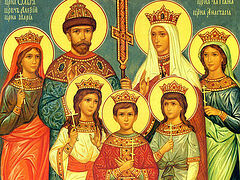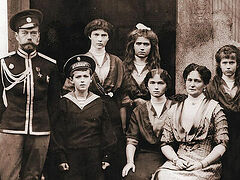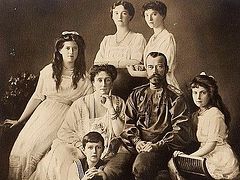 Emperor Nicholas II and Tsarevich Alexei with Kuban Cossacks from the Imperial Convoy in Mogilev, 1916
Emperor Nicholas II and Tsarevich Alexei with Kuban Cossacks from the Imperial Convoy in Mogilev, 1916
During the First World War, the eleven-year-old Heir to the Russian Throne, who headed several regiments and was the ataman of all the Cossack troops, visited the General Staff of the active army with his father and awarded soldiers for distinguished service. And he himself was awarded the silver Medal of St. George of the fourth degree for courage shown during his visit to a military hospital in a shelled area. The following incident that occurred at the Headquarters demonstrated that Alexei had a kind heart. When Sir John Hanbury-Williams, the head of the British military mission during the First World War, received the news that his son, who had fought in France, had died of wounds, the Tsarevich entered the next room, where the general was alone in his grief. Sitting down next to the Englishman, the child said, “Papa told me to sit with you for a while. He thought you’d feel lonely today.” By the way, meeting the Tsarevich at the Headquarters a year later, Sir Hanbury-Williams was amazed that he spoke several languages fluently.
The Tsarevich spent almost the whole of 1916 with his father at the headquarters of the Supreme Commander in Mogilev. According to A.A. Mordvinov, an aide-de-camp to St. Nicholas II, the Tsarevich “promised to become not only a good, but also an outstanding monarch.” Chief Marshal of the Court Count Pavel Benckendorff was of the same opinion about the Tsarevich:
“If the Lord had granted him a long life and saved him from his disease—usually disappears with age—then the Tsarevich would have played an important role in the revival of the long-suffering Motherland. After all, he was the rightful Heir to the Throne; his character had been developed in the crucible of adversity that had befallen his parents...”
In October 1904, during the Russo-Japanese War, a military hospital train named after the Tsarevich was launched. On June 16, 1905, the Alexeyevsky (“Alexei’s”) Committee was established, whose tasks included helping children who lost their fathers in the Russo-Japanese War. During the First World War, many military hospitals bore Alexei’s name. There were two institutions in Petrograd and at the Winter Palace: a hospital and a committee for lump-sum allowances for sick and wounded soldiers. The Grand Duchesses often visited all the hospitals. Tatiana Melnik-Botkina, the daughter of the physician St. Eugene Botkin, who treated Alexei, recalled:
“One day, the senior nurse of one of the hospitals asked the officers to tell Alexei Nikolaevich as much as possible about life at the front, and indeed he was so interested that when the Grand Duchesses who were in neighboring wards came to call him home, he said: ‘When I’m interested, you always leave early; but when I’m bored, you just sit there endlessly...’”
Meanwhile, the disease was making itself felt more and more acutely. It was because of his disease that the Siberian peasant Grigory Rasputin, who had the amazing ability to stop his bleeding, gained great influence over Tsarina Alexandra Feodorovna, who trusted him. She saw in him the last hope of saving her son. Even the warnings of the Empress’s sister, St. Elisabeth Feodorovna, that discontent with Rasputin among people was being transferred to the Royal Family, had no effect on the Empress and did not change her attitude towards the “elder”.
 Tsarevich Alexei Nikolaevich as a Lance-Corporal. 1916 In May 1916, Tsarevich Alexei was made lance corporal. He was becoming a young man. S. Ofrosimova recalled meeting him at the Cathedral of the Feodorovskaya Icon in Petrograd:
Tsarevich Alexei Nikolaevich as a Lance-Corporal. 1916 In May 1916, Tsarevich Alexei was made lance corporal. He was becoming a young man. S. Ofrosimova recalled meeting him at the Cathedral of the Feodorovskaya Icon in Petrograd:
“There is a festive service…The church is flooded with the glow of countless candles. The Tsarevich is standing on the Royal platform. He has almost reached the height of the Sovereign standing next to him. The glow of quietly burning icon lamps is reflected in his pale, beautiful face, giving it an unearthly, almost ghostly expression. His big, long eyes are looking with a serious, mournful look, not like that of a child… He is motionless as he faces the altar, where a solemn service is being celebrated… As I look at him, it seems to me that I had seen this pale face and these long, mournful eyes somewhere.”
On March 2 (15), St. Nicholas II abdicated the throne for himself and his son. He made this decision after consulting the surgeon of the imperial court, Professor Sergei Fyodorov, who told the Emperor that the Tsarevich’s life depended on any accident that could happen. The Tsarina asked Gilliard to inform the Tsarevich about the abdication. Gilliard feared that the terrible news would aggravate the condition of the Tsarevich, who had just contracted measles. Alexei’s reaction to his words shocked Gilliard:
“He blushed a lot and got agitated… But not a word about himself, not a single hint about his rights as the Heir to the Throne. Once again, I marvel at this child’s modesty, which is equal to his kindness.”
A new, sorrowful life began for the Royal Family under arrest. On March 19, A.A. Taneyeva saw
“the boatswain Derevenko sprawling about on the arm-chairs and ordering the Tsarevich to give him one thing or another. Alexei Nikolaevich, with sad and surprised eyes, was running around, obeying him.”
The boatswain turned out to be a Bolshevik and a fraud. He soon left the palace. This event saddened the Tsarevich very much. He loved this “uncle” so much. Then the soldiers of the revolutionary guard took away the Tsarevich’s toy gun. He burst into tears and grieved for his toy for a long time.
The fate of the Romanov family was sealed when the UK refused to give them refuge. In August 1917, Alexei Romanov, along with his family, was sent from Tsarskoye Selo into exile in Tobolsk. In exile, the Tsar finally was able to spend a lot of time with his beloved son and give him lessons personally. Alexei’s letter from Tobolsk dated January 22, 1918 has survived:
“Today it is 29 degrees below zero, with strong wind and sunshine… We have some good soldiers, and I play checkers with them in the guardhouse… Nagorny sleeps with me… It’s time to go and have breakfast. I kiss and love you. May God bless you.”
The last entry in his diary in Tobolsk is as follows: “How hard and boring.”
In early 1918, the Tsarevich’s disease made itself felt again. Tatiana Melnik-Botkina described the new onset of the disease in this way:
“Suddenly Alexei Nikolaevich took to his bed. It was a great blow for all of them, as he was suffering a lot again. He was having the same internal hemorrhage that had already emaciated him in Spala...”
The Empress wrote to A.A. Taneyeva from Tobolsk on April 10, 1918:
“Sunny has lost a lot of weight and is pale, with his huge eyes. It’s very sad. He likes it when we read aloud to him, but he eats too little...”
He was unable to move until his death.
On April 26, 1918, by order from Moscow Emperor Nicholas II, the Tsarina and Grand Duchess Maria were transported to Ekaterinburg; the sick Tsarevich Alexei was left in the care of the other sisters. On May 23, the Tsarevich, Grand Duchesses Olga, Tatiana and Anastasia were taken to Ekaterinburg as well. The Royal Family was placed in the house of the engineer N.K. Ipatiev.
 Sts. Alexandra Feodorovna and Nicholas II’s children under guard in Tsarskoye Selo. May 1917
Sts. Alexandra Feodorovna and Nicholas II’s children under guard in Tsarskoye Selo. May 1917
In Ekaterinburg, the life of the Royal Family was subordinated to a strict prison regime: isolation from the outside world, meager food rations, an hour-long walk a day, searches and the hostility of the guards. At this tragic time, joint prayer united the family, whose life was built on faith, hope and patience. At the request of the prisoners, the clergy were allowed into the “house of special purpose” rarely to celebrate services. The Tsarevich was always present at the services, sitting in a wheelchair. Surrounded by enemies, the prisoners were preparing for martyrdom. The Tsarevich wrote in his diary: “If they kill us, I only hope they won’t torture us for a long time...”
“Alexei took his first bath since Tobolsk; his knee is healing, but he cannot bend it completely. The weather is warm and nice. We have no news from the outside,” reads the last entry in Nicholas II’s diary, dated July 13, 1918.
A few days later, on the night of July 16–17, the Emperor and his family, along with their servants, were ordered to go down to the basement of the Ipatiev House. The monarch carried the sick Tsarevich Alexei in his arms. Twenty-three steps led down to the basement—it was the Royal Family’s path to their Golgotha. They were never to leave that terrible basement. They were shot by executioners from among those who promised our people “freedom and happiness”, which they were building on the blood of the Royal Martyrs and on the blood and suffering of millions of their compatriots. Sts. Nicholas II, Alexandra Feodorovna and Princess Olga were the first to die from bullets. The other children were still alive. According to the testimony of M.A. Medvedev, one of the executioners, it took several shots to kill the Tsarevich. Less than a month later Tsarevich Alexei would have turned fourteen.
 Nicholas II and his son in exile in Tobolsk. 1917
Nicholas II and his son in exile in Tobolsk. 1917
In 1981, the Royal Family was canonized by ROCOR. They were canonized among the New Martyrs of Russia at the Jubilee Bishops’ Council of the Russian Orthodox Church in August 2000.
Years and centuries will pass, but the shame of the Bolsheviks for shooting God’s Anointed and his family, for the deaths of the innocent royal children, who were like angels, will remain eternal! Tsarevich Alexei’s radiant image remains a symbol of Imperial Russia even after his death.
Holy Martyr Tsarevich Alexei, pray to God for the Holy Russian land and for its people!




